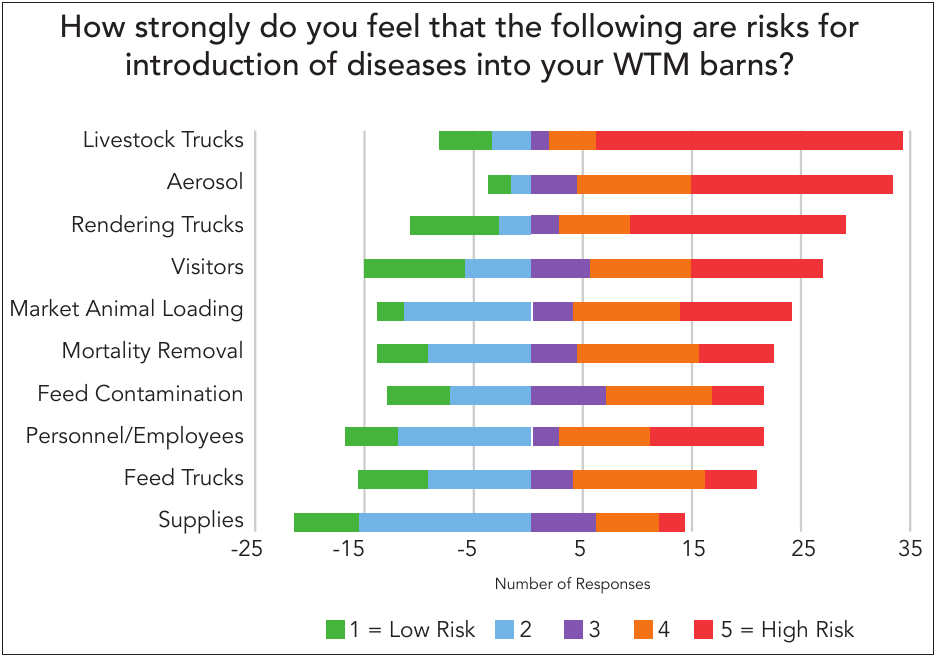Why is it important in wean-to-market barns?

Biosecurity. It is a big bold word but has it revolutionized the swine industry over decades? We go to extraordinary lengths to enhance sow farm biosecurity, which has historically been rewarded well. This begs the question: why do we not have near the standards for biosecurity in wean-to-market barns? Disease does not stop at the sow farm; however, biosecurity in wean-to-market sites is severely lacking to nonexistent.
What is the true definition of biosecurity? Every veterinarian and farmer will most likely have a different definition. A simple way to look at biosecurity: procedures and protocols that are in place to protect our pigs from disease. Less disease equals healthier pigs, reduces waste of resources, and creates a more sustainable pork product. It has been proven with many research trials that good, well executed biosecurity practices can decrease risk of disease to swine herds. That is why protocols like filters, feed mitigates, downtime, showering in and out of sites, and all-in all-out practices are in place in the swine industry. Less disease results in better economic gain, thus biosecurity is a no brainer.
Fourty-two producers were surveyed in the summer of 2022 to better understand their perspectives on wean-to-market biosecurity. When asked the question, “How much do biosecurity practices have an impact on health and return on investment?” 95% of the producers thought that biosecurity has a high impact when it comes to the sow farm. When asked the same question in relation to wean-to-market biosecurity, only 48% thought it was of high impact. Why is there such a difference in ranking of impact?
The survey participants were asked to rank key areas of biosecurity in order of low risk to high risk. In the graph below, the largest ranked high-risk areas were livestock trucks, aerosol and rendering trucks. Remarkably, more easily controlled biosecurity measures like supplies, feed, personnel/employees and mortality removal were ranked as lower risk.
These risk areas can be reduced with simple changes to the site and daily tasks.

How can you improve the biosecurity of your farm? A helpful strategy to understand wean-to-market biosecurity is the 5 P’s: Pigs, People, Products, Property and Pests.
Pigs
- When it comes to the pigs and biosecurity, there are many moving parts. A few being: animal health, vaccination status, animal entry and exit of a site, animal transport and mortality removal.
- In the biosecurity survey, three producers mentioned challenges with trucking such as lack of quality truck washes or trucker training as a barrier.
People
- People can bring in disease just as easily as pigs can. When it comes to people, biosecurity elements are visitor regulations, people entry and biosecurity training.
- In the biosecurity survey, twelve producers mentioned communication and compliance with contract growers as a concern, and ten producers wanted training of growers, truckers and themselves on protocols and continued reminders.
Products
- Feed, supplies and equipment can act as fomites (disease carriers) and bring pathogens to your site.
Property
- The wean-to-market property plays an important role in swine health. The site location, animal age on site and site sanitation all can impact pig health.
- In the biosecurity survey, nine producers mentioned their location (specifically pig density) as a barrier. Additionally, eight producers mentioned facility issues such as multi-age sites and older sites as issues. Three producers discussed mapping disease outbreaks or developing health levels of areas to assist in risk mitigation.
Pests
- Pests like rodents, birds and other pests can carry pathogens that can cause disease in swine.
Better wean-to-market biosecurity standards are a must for producers to keep herds healthy and stay competitive. To control the diseases we have such as PRRS and PEDV, along with ongoing efforts to prepare ourselves for the worst scenario of a foreign animal disease such as ASF, we are nowhere near where we need to be with the lack of biosecurity standards in place. Work with your PIPESTONE veterinarian to assess the practices in your operation, benchmark your farm, and make a commitment to raise the bar on wean-to-market biosecurity standards.
Article By: Dr. Rachel Stika Jensen Pipestone Veterinary Services
